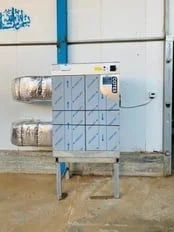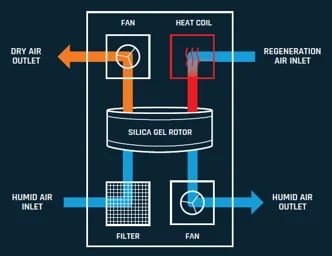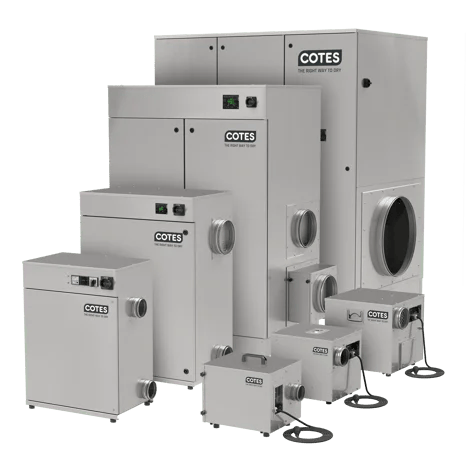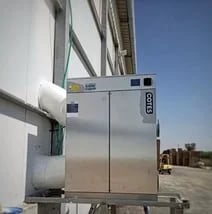THE CHALLENGES OF INDUSTRIAL REFRIGERATION
The temperature inside a refrigerated facility is usually between 3 and 5°C which is why ice formation does not normally occur. However, ice can form on evaporators where the surface temperature is often lower than 0°C. Condensation caused when wet air makes contact with cold surfaces is a common problem in many climates. In the wrong places, humidity creates significant problems.
High relative humidity in industrial refrigerated facilities can create:
- Condensation on cold surfaces, fixtures and the stored goods
- Mould and bacterial growth, leading to hygiene hazards
- Moisture formation on stored goods, resulting in damaged packaging or spoilage of the goods themselves
- Ice forming on walls, ceilings, floors and storage fixtures can cause accidents and other safety risks
- Corrosion on structures, fittings and equipment
- Reduced energy-efficiency
- Poor working environment
The above problems naturally result in high maintenance costs, costly write-offs and even loss of customer contracts if spoiled goods get to the customer. For avoiding such unpleasant situations, dry-air solutions that allow for full humidity control are the solution.
ELIMINATING COSTLY LOSSES AND PROTECTING VALUE
When building a new refrigerated facility, it is possible to account for humidity management solutions into the design and budget from the very beginning. This will save both headaches and money in the future. Cotes recommends considering:
- Rapid-action doors to prevent humidity from entering the facility
- Keeping the number of openings and gaps in the structure to a minimum to reduce places where humidity can enter
- Efficient sluices
- A low evaporator temperature or a system to control the evaporator temperature if needed
In older refrigerated facilities, it is likely that the above-mentioned considerations have been overlooked or ignored due to other priorities such as logistics and wanting to maximise the storage space. In this case, it is recommended to do a comprehensive investigation into the right dehumidification processes for the facility, to remove already existing humidity issues or prevent them before it is too late.
CASE STUDY: ONION STORAGE COOLING ROOMS
Many branches of the food industry require proper humidity management to ensure food quality. Industrial storage of many food products requires refrigeration with specific levels of relative humidity for that product. Cotes' partner, Einav Technologies, chose dehumidification solutions from the C-range for an installation in onion storage cooling rooms. Different models of the C65 dehumidifiers were installed outside the cooling rooms with ducts in a protected place.

|
Images from the installation |

|
In the first stage, the onions need to be dried to prevent rot. The drying stage takes 12-24 hours in conditions at a temperature of 20-30°C and 70% RH. Secondly, the onions are stored at a colder temperature to maintain stability. The cooling stage happens at 1-2°C and 65-75% RH.
HOW THE ONION STORAGE FACILITIES BENEFIT FROM PROPER DEHUMIDIFICATION
Where humidity problems can affect business operations, prevention is always better than cure. Rather than tackling humidity-related symptoms in the onion storage facility, Cotes dehumidifiers allowed for dealing with potential issues right at the start of the process and made it possible to:
- Control the air quality in the facility more effectively
- Minimise product damage and write-offs, maintain product value and boost customer satisfaction
- Improve hygiene
- Lower energy expenses by using Cotes' unique heat recovery modules
- Minimise maintenance costs by preventing corrosion and damage to the structure and equipment
WHY COTES DRY-AIR SOLUTIONS were RIGHT FOR THE JOB
- Highly energy-efficient solution using thermal inputs from cooling installations, heating and ventilation
- Exceptional control capabilities to specifically fit the conditions of the refrigeration facility
- Compact, robust and reliable design
- Built for long service life
- Good return on investment
"A large diameter of the rotor with a relatively narrow depth allows drying of large amounts of air quickly. Cotes dehumidifies are considered more efficient and effective than any other solution." -Li-At Cohen, Business Development and Branding at Einav Technologies
Cotes dehumidifiers help prevent humidity-related issues from arising in the first place. By choosing Cotes dehumidification solutions, you gain many cost and operational benefits as well as contribute to a greener future with our sustainable technology.

Image: The process of adsorption dehumidification
THE BEST DEHUMIDIFIERS SUITED FOR INDUSTRIAL REFRIGERATION
The volume of the refrigerated storage space and the required relative humidity level are usually the main determinants for exactly which Cotes adsorption dehumidifier will most effectively meet your operating needs. Cotes adsorption dehumidifiers are an effective and sustainable choice.
For industrial refrigerated facilities, Cotes' C-Range can be the solution you are looking for. Dehumidifiers from this versatile and elegant range include add-on modules for extra functionality ensuring exceptional reliability and energy efficiency. The add-on modules can be selected to fit specific customer needs, making them very customisable.

Image: Cotes adsorption dehumidifiers
Do you have issues with humidity?
If you would like to determine whether you need a dry-air solution in your production facilities or would like to explore what a custom dry-air strategy can do for your business, please reach out to one of our trusted partners near you.Find a Cotes Partner near you
